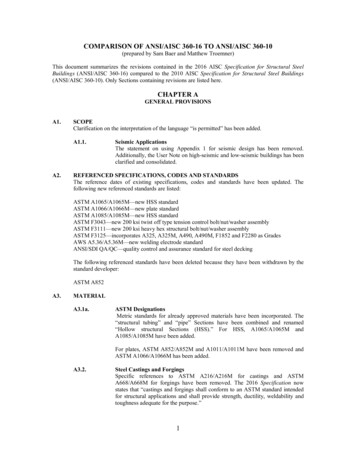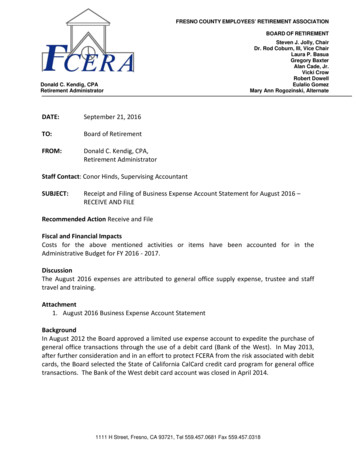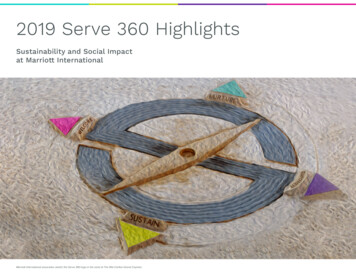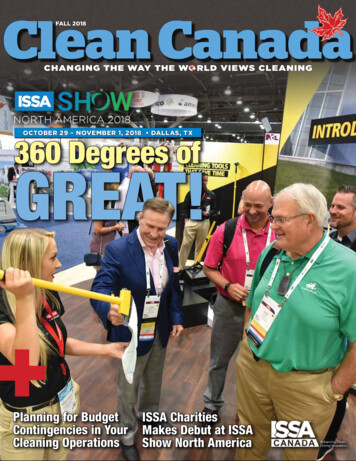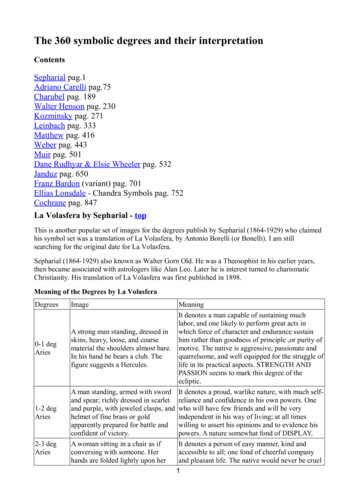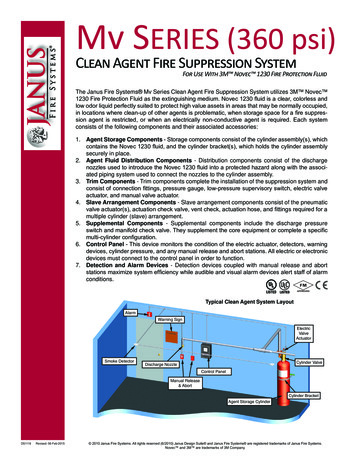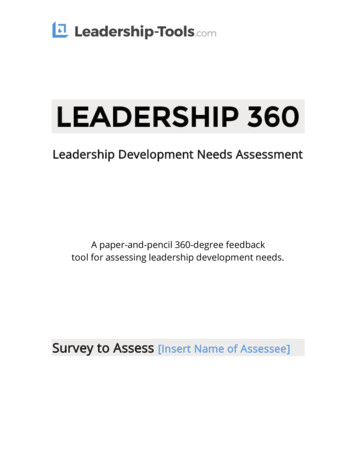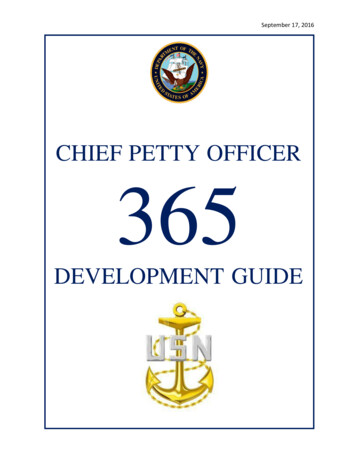
Transcription
September 17, 2016CHIEF PETTY OFFICER365DEVELOPMENT GUIDE
Page Intentionally Left Blank2
I am a United States Sailor.I will support and defend the Constitution of the United States ofAmerica and I will obey the orders of those appointed over me.I represent the fighting spirit of the Navy and those who have gone before me to defendfreedom and democracy around the world.I proudly serve my country's Navy combat team withHonor, Courage, and Commitment.I am committed to excellence and the fair treatment of all.MISSION, VISION, GUIDING PRINCIPLES FOR CHIEF PETTY OFFICERSDeckplate Leadership Chiefs are visible leaders who set the tone. Chiefs will know the mission, know their Sailors, and develop them beyond their expectations as a team andas individuals.Institutional/Technical Expertise Chiefs are the experts in their field. Chiefs will use experience and technical knowledge to produce a well- trained enlisted and officer team.Professionalism Chiefs will actively teach, uphold, and enforce standards. Chiefs will measure themselves by the success of their Sailors. Chiefs will remain invested in the Navy through self-motivated military and academic education and training. Chiefs will provide proactive solutions that are well founded, thoroughly considered, and linked to missionaccomplishment.Character Chiefs abide by an uncompromising code of integrity, take full responsibility for their actions, and keep theirword. Chiefs always seek to set a positive tone for the command, unify the Mess, and create esprit de corps.Loyalty Chiefs remember that loyalty must be demonstrated to seniors, peers and subordinates alike, and know that ismust never be blind. Chiefs must have the moral courage to question the appropriate direction in which an organization is headedand then the strength to support whatever final decisions are made.Active Communication Chiefs encourage open and frank dialogue, listen to Sailors, and energize communication flow up and downthe chain of command. Chiefs always must seek to actively communicate in a way that increases unit efficiency, mission readiness,and mutual respect.Sense of Heritage Chiefs make heritage a priority, using it to define our past and guide our future. Chiefs will use heritage to connect Sailors to their past, teach values, and enhance pride in service to ourcountry.3
Page Intentionally Left Blank4
Table of ContentsSailor’s Creed .3References, Resources and Acknowledgments .7MCPON Guidance Memorandum (MGM) #2016-01 .102015-2016 CPO 365 Guidance .10General Guidance for CPO 365 .12Phase I .13Phase I Training Guidelines .13Phase I Responsibilities .15Phase I Physical Fitness Training .15Introduction .16Physical Readiness and Fitness Performance.19Phase I Section I: Building a Foundation .20Fundamentals: Understanding Brilliant on the Basics .22Fundamentals: Understanding Deckplate Leadership .27Fundamentals: Understanding Institutional and Technical Expertise .30Fundamentals: Understanding Professionalism .33Fundamentals: Understanding Character and Loyalty.36Fundamentals: Understanding Active Communication .39Fundamentals: Sense of Heritage.42Required Reading.45Quincy Truett Story .45Leadership Development .48Leaders and Learning Styles .55Leadership Styles and Power Bases .61Matching your Leadership Style to the Situation .68Personal Leadership Essay .73Phase I Section II: Tasks and Qualifications to Strengthen Leadership Skills .75Task 1: Ranking Boards and Writing Evaluations .77Task 2: Writing Awards .84Task 3: Career Development Board .87Task 4: Developing a Lesson Plan .90Task 5: Writing a Letter of Instruction (LOI) .94Task 6: Understanding Electronic Correspondence .99Task 7: Draft a Plain-Paper Memorandum .100Task 8: Advancement Process and Requirements .102Phase I Section III: Enhanced Development .107Task 1: Managing Your Records .109Case Study #1: All in a Day’s Work .115Case Study #2: DIVO Performance .1175
Case Study #3:Case Study #4:Case Study #5:Case Study #6:Teach, Educate, Attack, and Measure .120Welcome to the Mess.123Can Do! .126Heritage Challenge .1296
REFERENCES1. OPNAVINST 1740.3 (Series) Command Sponsor and Indoctrination Program2. OPNAVINST 1750.1 (Series) Navy Family Ombudsman Program Manual3. OPNAVINST 1040.11 (Series) Navy Enlisted Retention and Career Development Program4. NAVPERS 15878(Series) Bureau of Naval Personnel Career Counselor Handbook5. Chief of Naval Operation Policy and Guidance6. SECNAVINST 1650.1 (Series) Navy and Marine Corps Awards Manual7. NAVADMIN 149/13, 150/13 Career Waypoints8. MILPERSMAN 1306-618 Class ‘A’ School and Rating Entry Requirements9. Career Information Management System (CIMS) Users Guide/Billet Based Distribution(BBD) User Guide10. MILPERSMAN 1160-120 High Year Tenure11. MILPERSMAN 1920-030 Involuntary Separation Pay (Non-Disability) – Definitions andPolicy12. OPNAVINST 6110.1 (Series) Physical Readiness Program13. OPNAVINST 5350.4 (Series) Navy Alcohol and Drug Abuse Prevention and Control14. OPNAVINST 5354.1 (Series) Navy Equal Opportunity Policy15. OPNAVINST 5370.2 (Series) Navy Fraternization Policy16. SECNAVINST 1752.4 (Series) Sexual Assault Prevention and Response Program17. OPNAVINST 1752.1 (Series) Sexual Assault Prevention and Response (SAPR) Program18. SECNAVINST 1740.4 Department of the Navy (DON) Personal Financial Management(PFM), Education, Training, and Counseling Program19. OPNAVINST 1754.2 (Series) Exceptional Family Member (EFM) Program20. MILPERSMAN 1300-700 Exceptional Family Member Program21. SECNAVINST 1752.3 (Series) Family Advocacy Program (FAP)22. OPNAVINST 1752.2 Family Advocacy Program23. OPNAVINST 1720.4 (Series) Suicide Prevention Program24. MILPERSMAN 1770-090 Reporting Requirements for Suicide Related Behaviors25. SECNAVINST 1610.2 (Series) Department of the Navy (DON) policy on Hazing26. OPNAVINST 1770.1 (Series) Casualty Assistance Calls and Funeral Honors SupportProgram Coordination (CAC/FS)27. MILPERSMAN 1770-160 Casualty Assistance Calls Program (CACP)28. MILPERSMAN 1770-280 Death Gratuity29. OPNAVINST 3500.39 (Series) Operational Risk Management (ORM)30. OPNAVINST 5100.12 (Series) Navy Traffic Safety Program31. OPNAVINST 6000.1 (Series) Navy Guidelines Concerning Pregnancy and Parenthood32. SECNAVINST 1850.4 (Series) Department of the Navy (DON) Disabilities EvaluationManual33. MILPERSMAN 1306-1200 Limited Duty (LIMDU)34. OPNAVINST 3120.32 (Series) Navy Standard Organization Regulations of the Navy35. OPNAVINST 1306.2 (Series) Command Master Chief Program36. Chief Petty Officers Mission, Vision, and Guiding Principles37. Winds of Change - Charlotte D. (Roberts) Crist38. OPNAVINST 5100.19 (Series) Navy Safety and Occupational Health (SOH) Program7
Manual39. OPNAVINST F3100.6 (Series) Special Incident Reporting40. BUPERSINST 1610.10 (Series) Navy Performance Evaluation SystemNote: References listed are not all encompassing. The listed references are provided as a startingpoint to provoke thought. Use any reference you feel would be beneficial to addressing the task.The following links will provide access to the current instructions/manuals:- Navy- Navy Personnel Command- MILPERSMAN- Navy Knowledge On-Line- Navy Operational Fitnessand Fueling Series- Navy History and HeritageCommand- OPNAV/SECNAVINST- Navy Family Line- Naval Safety Center- Navy and Marine Corps- Navy IA Site- Navy Family Accountabilityand Assessment System- Military One Source- Navy Fleet and pecial Note: All SELs should ensure references listed in the CPODG are available viaINTERNET, Command Web Site, or hard copy in order for Sailors to complete the CPODG.Requests for materials can be made directly to NPC by contacting NPC Helpdesk at1 (866)-U-ASK-NPC or Email at CSCMAILBOXMAILBOX@NAVY.MIL.Additional resources can be found at the following links:-CPO 365 Training Resources - http://www.365chief.com/index.html-NPC Website - t.aspx-Naval History - http://www.history.navy.mil/-21st Century Sailor - -NOFFS - http://www.navyfitness.org/-PT Plans - http://www.navy-prt.com/files/Personal Training Plan.pdf-Keep What You’ve Earned Campaign http://www.public.navy.mil/bupersnpc/support/21st Century Sailor/nadap/campaign events/drinkresponsibly/Pages/default.aspx8
ACKNOWLEDGEMENTSa. U.S. Fleet Forces Public Affairs article: Navy Clarifies IA Parent Command Responsibilitiesdated, Friday, July 10, 2009.b. USNI Proceedings article, Where’s the Chief dated February 1995, Authored by CaptainChristopher H. Johnson, U.S. Navy.c. WWW.NAVY.MIL (web site) Navy Core Values defined by unknown author. Review date(posted): 12 August 2009.d. All Hands Magazine of the U.S. Navy 53rd year of publication. Edition number 708 January1976.e. History of the Chief Petty Officer Grade authored by CWO4 Lester B. Tucker, USN (Retired).Article provided was reprinted from Pull Together: Newsletter of the Naval HistoricalFoundation and the Naval Historical Center, Vol. 32, No. 1 (Spring-Summer 1993).f. All Hands Magazine of the U.S. Navy. Edition number 1096 July 2008. Article; First therewere Firsts authored by James L. Leuci, ITCM, USN9
MCPON GUIDANCE MEMORANDUM (MGM) #2016 - 01DEPARTMENT OF THE NAVYMASTER CHIEF PETTY OFFICER OF THE NAVY2015-2016 CPO 365 GuidanceIt is well known that Chief Petty Officers (CPOs) are professional leaders who areaccountable individually and together as a CPO Mess for our actions. Each of us has theresponsibility to understand and follow the policies and regulations of our profession. CPO365 is designed as the single sustained leadership training method for our entire CPO Mess.This guidance provides us with commonality of purpose as we safely and effectively developChief Petty Officers.CPO 365 has been and will continue to be an evolutionary process, as Chief Petty Officers,spanning the globe, continue to embrace CPO 365 with their own unique spirit. Regardless ofgeographic coordinates, it opens minds and contains focused objectives that are commondenominators towards enduring progress. Collaboration among counterparts also hasphenomenal potential in dispersing best practices. It is okay, even encouraged, to share howyour Messes are keeping the fire alive and emulating what others are doing.As delegated by the Chief of Naval Operations (CNO), the Master Chief Petty Officer of theNavy (MCPON) is responsible for developing and overseeing the implementation of CPO 365Guidance. This guidance will provide the Chief Petty Officers Mess with a universal, safe,and effective method of training for all future CPOs to meet the mission of the Navy. Thismust be done in a manner that is in keeping with the Navy's Core Values, regulations andlaws.As described in Navy Regulations, Commanding Officers (COs) are singularly accountablefor the safe, successful execution of training within their Commands or Units. As delegatedby the CO, unless otherwise directed, it is the responsibility of the Command Senior EnlistedLeader (CSEL) to serve as their CPO 365 direct representative and be keenly involved frombeginning to end. Aside from thorough process preparation, CSELs will brief the CO on theirCPO 365 process and provide regular updates to keep them informed of progress. As ChiefPetty Officers, it is our duty and responsibility to train our reliefs, and critical, that we be allin and fully engaged with CPO 365. CSEL leadership reinforces the conviction that CPO 365is instrumental to the professional growth of Sailors and relevant to command success.10
We should all be proud of our CPO 365 program and possess confidence that it preserves theright traditions while preparing our First Class Petty Officers (FCPOs) for promotion to thenext paygrade. Both objectives stand essential to the esteem of our Mess and the professionalprosperity of our Sailors. Your leadership, your commitment, and your energy are the fuelfor this process . they will keep this distinguished institution, our U.S. Navy Chief Petty Officers' Mess,vibrant and meaningful. I want to emphasize the significance of our Navy Ethos, NavyCore Values, and Chief Petty Officer Mission, Vision, and Guiding Principles (MVGP).Chief Petty Officers are one of the most respected groups of enlisted leaders in the world.Our responsibility is to ensure we provide the type of education and training that makes thisstatement true today and in the future.I expect every Chief Petty Officer to read this guidance in its entirety, and for all CPOMesses to discuss it as groups. While the guidance is not all-inclusive, it does provide aproven foundation for effectively developing a new generation of CPOs. Solid leadership,sound judgment, common sense, and situational awareness need to prevail in all situations notexpressly covered in this document. I have the utmost confidence in your ability as a Mess tocontinue to build upon the legacy of success forged by all that have worn anchors.MIKE STEVENSMaster Chief Petty Officer of the Navy11
General Guidance for CPO 365CPO 365 guidance affords command leadership the flexibility to conduct education andtraining in alignment with the Navy Ethos, Navy Core Values, and CPO MVGP. Thisguidance does not include every aspect of how we develop new Chief Petty Officers nor doesit specify every right or wrong.The two phases of CPO 365 are designed to ensure our CPO Mess and FCPOs are continuallyand steadily developing to succeed in future leadership positions. CPO 365 needs to challengeall of us physically and intellectually, and hone the principles of accountability, integrity,toughness, and initiative. With honest all-around effort during Phases I and II, CPOs andFCPOs will have a solid foundation that supports heightened success.CSELs are singularly accountable for the safe, successful execution of education and training;however, as Chief Petty Officers we all have a duty and responsibility to train our reliefs, andit's critical that we be all-in and fully engaged with CPO 365. Respect the dignity and welfareof all participants while pushing one another to new limits; we deserve, and should expect,nothing less. Done correctly, this process will never come close to anything that can beconstrued as hazing.Keep the process constructive and professional; CSELs will brief Commanding Officers ontheir local CPO 365 process ·and provide regular updates to keep them informed of progress.CSEL leadership reinforces the conviction that CPO 365 is instrumental to the professionalgrowth of Sailors and relevant to command esprit de corps.Involve the wardroom early and often. Effective commands leverage the synergy of healthywardroom/CPO Mess relationships to strengthen teamwork and trust. Junior and mid-gradeofficers participating in today's process will become tomorrow’s Commanding Officers.Involve families early and often. Be transparent; keep them up to speed on training schedulesand invite them to participate whenever possible. Frequent family engagement goes muchfurther in demonstrating the importance of them to our readiness and career success--they willwelcome the inclusion.Other service/nation participation for E-7 and above is authorized, granted they participate forthe entirety of Phase I and Phase II. At the discretion of the gaining CPO mess, a person canstart at one command and complete the training at another command.While fundraising accomplishes some of the team-building goals of an effective CP0-365program, fundraising is conducted year-round b
CPO 365 is designed as the single sustained leadership training method for our entire CPO Mess. This guidance provides us with commonality of purpose as we safely and effectively develop Chief Petty Officers. CPO 365 has been and will continue to be an evolutionary process, as Chief Petty Officers,File Size: 1MB
